The Writers Workbench
Can You Ear Me Now?
Robert J. Elisberg
Earlier in the year, we took a look (or “listen” is probably the better term) at small portable speakers. But sometimes you want something more personal, and only earphones or headphones will do. So, this month, to round out the year, we’ll check out a wide range of them. From the reasonably high-end (though affordable) to the even-more moderate.
There’s always a challenge when dealing with any sound-related device, a hurdle which is exacerbated with headphones and earphones – it’s all so personal. Some people live for deep, rich booming bass, some only want to hear soaring treble. And what is crisp to one ear might be muddied to another.
I got a bit of comfort with this conundrum earlier in the year when I came across an article on the CNET website, written by their expert in sound, a fellow named Steve Guttenberg, who goes by the name of “The Audiophilliac.” And I figured that if he was okay with his theory, then that’s good enough for me.
The article, which you can read in full here, dealt with the idea of that sound devices don’t have to be at the impeccable level demanded by audiophiles, but that something lesser might be just what you need. Indeed, the title of the piece was “’Good Enough’ speakers and headphones might be good enough after all.”
The basis of his theory was his discovery when playing a high-resolution digital version of a favorite, old, classic rock album. And it just didn’t sound as good to him as in the past lower-resolution days. And so he then played his old LP to compare. And he realized that what was bothering him now didn’t bother him years before for a simple reason – “That's because speakers back in the day didn't reveal the full measure of music's grit and crud,” whereas today’s high-quality speakers or headphones let you hear all the harsh sounds.
That’s when he came up with his simple solution – play the digital recording over ordinary speakers or earphones “and the recording's sound quality won't be an issue. The sound will be good enough.” Perhaps less is more, he says, and then suggests that headphones or speakers which can make average recordings “palatable” might actually make the most sense.
He wasn’t saying to forsake high-end speakers or earphones, because today there’s so much material that demands it. And so he concludes, “I love music, but I mostly listen to great sounding recordings, where the best headphones and speakers let the music shine. But my tastes aren't all that mainstream, so I'm self-selecting music that sounds good on my system. I'm starting to see the light: most people are using headphones and speakers that make the music they like sound good to them. I don't have a problem with that, whatever works is good enough.”
So, in the end, if that’s what an audiophile has discovered, perhaps that’s the answer to the conundrum. Writing about earphones here is utterly subjective. Not only might your mileage vary, it will. So, look for what tends to be of most interest to you, and no one else, and if you find something here that strikes your fancy, then that’s what – for you – will be good enough.
- Audio-Technica ATH-MSR7 Hi-Res Headphones
- Phiaton BT 220 NC wireless ear buds
- Phiaton BT 330 NC Headphones
- HMDX Craze Wireless Ear Buds
- TWW Notes
AUDIO-TECHNICA ATH-MSR7 HI-RES HEADPHONES
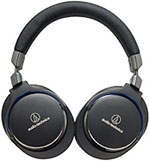 Audio-Tehnica is a company that makes very good quality sound headphones for the home market though at a price generally quite a bit lower than other high-end devices on the market. (To be clear, they also make audiophile and professional-level products.) The ATH-MSR7 is one of those high-quality home products that falls into the affordable range.
Audio-Tehnica is a company that makes very good quality sound headphones for the home market though at a price generally quite a bit lower than other high-end devices on the market. (To be clear, they also make audiophile and professional-level products.) The ATH-MSR7 is one of those high-quality home products that falls into the affordable range.
For most people these headphones might be more than they’re looking for, but if you have relatively demanding needs, they might be worth looking into since comparable headphones could cost you several hundred dollars more. Whether you’re the sort for whom that extra cost is worth it or not, well…that’s what we’re here to find out. As a starting point, though the ATH-MSR7 retail for $250, though the online price at the time of writing is only a few dollars less.
Audio-Technica marks these headphones as “Hi-Res Audio,” a designation they don’t give to all their high-quality earphones. The Hi-Res logo is a certification that the device meets official Hi-Res Audio standards. (That means headphones are required to have “transducer frequency performance to at least 40 kHz.” If you’re scratching your head at that, don’t worry it means you likely should look for other headphones or be willing to accept the more human explanation that these can reproduce especially high quality audio.)
Other techie jargon is that they’re made with exclusive 45 mm True Motion Drivers, which use lightweight voice coils, and proprietary technology to improve audio response and minimize distortion. The bottom line for most people though is how do they sound, and feel on the head, and what bells-and-whistles do they offer.
These are over-ear headphones, which allow for less outside noise and distortion, though adds slightly to the weight. But the weight isn’t too bad at all. I found the memory foam cushions comfortable, and the headband didn’t feel like I had a brick sitting on my head. Of course, the longer you listen – like on a long flight, the more wearing they’re likely to be.
It also comes with three detachable cables – 4-feet and 10-feet, as well as a 4-foot cable with in-line controls and a microphone if you prefer to use the earphones with a Smartphone, or control playback directly from the earphones themselves. They come in black or gun-metal, and include a carrying pouch.
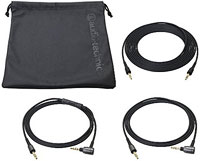 The sound quality is very good, though as noted above all of that is personal taste. I found the audio to be clear and crisp, with a strong bass, though not a depth for those who like their bones to shake. The treble didn’t soar into the sky, but it had a clarity that I found very pleasing. A lot of the response, too, likely depends on the media you’re playing, and mine that I tested it on probably didn’t push these headphones to their fullest. I found the controls fairly easy to use, and well-designed. And overall the construction was excellent.
The sound quality is very good, though as noted above all of that is personal taste. I found the audio to be clear and crisp, with a strong bass, though not a depth for those who like their bones to shake. The treble didn’t soar into the sky, but it had a clarity that I found very pleasing. A lot of the response, too, likely depends on the media you’re playing, and mine that I tested it on probably didn’t push these headphones to their fullest. I found the controls fairly easy to use, and well-designed. And overall the construction was excellent.
I quite liked the ATH-MSR7. The quality of sound is terrific for a mid-range price. If you want higher quality sound, there are many models, but you’ll pay dearly for the privilege. However – I’m not an audiophile. And as a result, even though their price is impressive for something this well-made, I’ve used much less expensive headphones that produced almost comparable sound to my ears that met personal needs (as Mr. Guttenberg notes above). Also, if you like to travel with your headphones for airplane trips, I prefer light, pocket-sized models. To be clear, though, these from Audio-Technica fold up nicely, and I like the soft pouch which decreases the size, as well. (Hard-cases are more protective, but use up much more space.)
So, almost more than any of the other earphones reviewed here, I think the Audio-Technica ATH-MSR7 fall into the “it really depends on your taste and needs” category. They’re very good at a very reasonable price. What you need, though, is of course up to you.
PHIATON BT 220 NC WIRELESS EAR BUDS
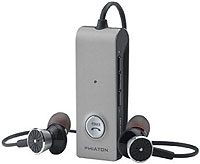 A couple years back, I reviewed a set of small, Bluetooth noise-cancelling in-ear headphones from Phiaton, a very good company that offers a wide range of audio products. It was the PS 210 BTNC, and I liked it very much, but with a few caveats, most notably that although it was very well-built, there were two design issues. The cover over the slot on the bottom where you plug in audio cable and charger cable seems extremely flimsy and likely to break off. And the thin, spring-clip for attaching to your clothes was so flimsy that it did break off.
A couple years back, I reviewed a set of small, Bluetooth noise-cancelling in-ear headphones from Phiaton, a very good company that offers a wide range of audio products. It was the PS 210 BTNC, and I liked it very much, but with a few caveats, most notably that although it was very well-built, there were two design issues. The cover over the slot on the bottom where you plug in audio cable and charger cable seems extremely flimsy and likely to break off. And the thin, spring-clip for attaching to your clothes was so flimsy that it did break off.
The BT 220 is a long-awaited upgrade, and it’s worth the wait, since the major issue was resolved. It now has a very solid, substantive “full body” clip that feels like it’s there to stay, being basically built into the body of the device. That cover is still flimsy, but it’s not a big deal, since even if it broke off, that would simply leave the port open like on most devices. It’s the new, vastly-improved clip that’s the notable fix.
Though the headphones are Bluetooth 4.0, they also can be used wired, snapping on the included cable, though they're best designed for wireless. There’s also a built-in mic for cell phone use.
The BT 220 now include NFC tap-to-pairing which lets you connect to any NFC-enabled Bluetooth device without having to go through your settings. It also now allows for multi-point connection and can connect to two devices at same time (for example, a phone and tablet).
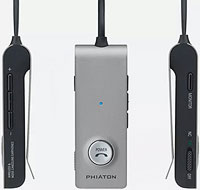 A dongle contains all the controls (volume, fast-forward, reverse, phone pick-up and such), and this is another improvement. Before there was a sort of “jog wheel” that worked fine, but wasn’t completely intuitive. Now, there are clear, separate buttons. It takes a bit of dexterity for learning how long to hold down each, but it’s easy enough, especially once you get the grasp. The dongle can be clipped on to one's clothing – with great ease now, as mentioned, without any concern of breaking off – or used with the included neck strap, which is useful for jogging. There is also now a “monitor” button which mutes sound, which lets you to hear, for instance, a flight attendant. The dongle itself is reasonably light, though you'll feel a drag which clipped on. The earbud headphones themselves are very light and sit extremely comfortably. Sound quality has always been one of Phiaton’s strong points, and remains so here, for such a small device (about the size of a pack of chewing gum), still impressively good. The high-end treble remains crisp, and although the bass isn't deep, it's clear and well-rounded. There isn’t the widest separation, but the sound comes across with a pleasant richness. All Bluetooth sound devices compress the audio which causes a slight muddying, but it's slight here. And any muddying disappears if you snap in the wire to connect directly to your music player. As before, I didn't notice any change to sound quality when the noise cancelling was turned on, which can sometimes affect the audio.
A dongle contains all the controls (volume, fast-forward, reverse, phone pick-up and such), and this is another improvement. Before there was a sort of “jog wheel” that worked fine, but wasn’t completely intuitive. Now, there are clear, separate buttons. It takes a bit of dexterity for learning how long to hold down each, but it’s easy enough, especially once you get the grasp. The dongle can be clipped on to one's clothing – with great ease now, as mentioned, without any concern of breaking off – or used with the included neck strap, which is useful for jogging. There is also now a “monitor” button which mutes sound, which lets you to hear, for instance, a flight attendant. The dongle itself is reasonably light, though you'll feel a drag which clipped on. The earbud headphones themselves are very light and sit extremely comfortably. Sound quality has always been one of Phiaton’s strong points, and remains so here, for such a small device (about the size of a pack of chewing gum), still impressively good. The high-end treble remains crisp, and although the bass isn't deep, it's clear and well-rounded. There isn’t the widest separation, but the sound comes across with a pleasant richness. All Bluetooth sound devices compress the audio which causes a slight muddying, but it's slight here. And any muddying disappears if you snap in the wire to connect directly to your music player. As before, I didn't notice any change to sound quality when the noise cancelling was turned on, which can sometimes affect the audio.
One thing I’ve particularly noted about Phiaton is that noise cancelling is seriously good. The company says the PS 220 will block out 95% of background sounds, and I wouldn't be surprised if that was accurate – external noise was drastically muted. Noise cancelling is activated with a well-marked switch.
As mentioned, the Phiaton can be used with wired, but this is clearly designed for being primarily a wireless Bluetooth device, with the audio cable a separate add-on. The downside is that it can be lost. The upside is that this makes for a far more elegant, convenient device if you plan to mostly use it via Bluetooth. Note that it comes with a nice, little carrying sack, so it’s easy to store the cable wire. Also, know that when the wired audio cable is connected, this overrides the Power button. That means you can't use any of the volume or direction buttons on the dongle.
Speaking of the Power button – it doesn't just flip on or off like most. You must hold it for a few seconds. A nice touch is that the device provides voice confirmations that play through the earbuds (telling you things like "Power is on," "Bluetooth is on," "Bluetooth connected," which takes out the guesswork.)
The Phiaton is very well-built and has an elegant design. The ear buds are a "half-in-ear" design that fits well in your ear canal. Four different-sized Silicone ear tips are included, as well as one set of foam “Comply Memory” ear tips. Also included are a USB charger cable and aforementioned carrying pouch. The pouch "snaps" open and closed – which is perhaps more protective, though a touch bulkier than a draw string. It has a built-in rechargeable battery, which uses a micro-USB cord. None is included, but most people likely have dozens lying around. The earphones have a pretty long battery life, and are rated for 17 hours of music, and 16 hours calling time (both with the noise-blocker turned off, runtime will be shorter) – this is about a 33% improvement from the earlier model. Standby time is 300 hours, very good though a significant drop from 500 hours before.
The Phiaton BT 220 headphones are an extremely high quality, small and light multi-purpose headphones, with very good sound and excellent noise cancelling. They’re particularly best-suited for Bluetooth use. If you exclusively prefer to use your headphones with a connected wire, however, for the best sound, other choices might be better. (I’ve also been using the equally small Audio-Technica ATH-ANC23 for several years, when I know for sure I want to go “wired.”) But as before, if you're a wireless soul, that's what these are designed for. And of course, having the removable cord makes these more versatile than wired-only. Further, the upgrade improvements really fixed my main quibbles from before. The BT 220 does come at a cost – they retail for $179, but could be found online at the time of writing for $159.
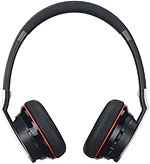 Phiaton’s BT 330 NC Headphones are a different look at wireless Bluetooth headphones from the company. These are slightly higher end headphones, with on-ear foam pads. They’re also larger, not pocket-sized, at 4”x8.4”x5.8”, but they’re reasonably small and only seven ounces, so they’re quite light to pack in a briefcase or carry-on.
Phiaton’s BT 330 NC Headphones are a different look at wireless Bluetooth headphones from the company. These are slightly higher end headphones, with on-ear foam pads. They’re also larger, not pocket-sized, at 4”x8.4”x5.8”, but they’re reasonably small and only seven ounces, so they’re quite light to pack in a briefcase or carry-on.
Those wireless, there’s also a small cord for plugging into a music player when you want the highest-quality sound. But even when used via Bluetooth, the sound was very impressive for a reasonably-priced device. Very crisp audio with clear treble and solid bass, though for those who like your bones to rattle, there isn’t a booming resonance. It’s not at audiophile level, but you aren’t paying anywhere near that. All-in-all, it’s a very pleasing, smooth sound. As with all Bluetooth devices, the audio is slightly degraded unless you use the included wire which connects the headphones directly to your music player, but I found the wireless drop in quality quite small.
Unlike the above-reviewed BT 220, there is no dongle that hangs down. The controls are all built into the headphones. They’re easy to use, with separate buttons, though oddly the manual makes things seem problematic. (The graphic has a dot marked “press” before every function, but that is poorly phrased and admittedly befuddled me for a while. If you press the button first before everything, as the directions appear to say, it pauses things. What you do, though, is “slide” the button to adjust the sound, fast-forward or jump tracks.) To be clear, this is a hiccup in the instructions, not the unit itself which works fine.
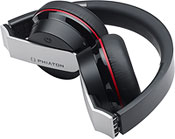 The headphones have a rechargeable battery, and a micro-USB charging cable is included. Runtime is quite respectable – 14 hours for music with noise-cancelling on, double that with it off. For talking with the built-in mic, it’s about the same. Standby is rated at 29 hours if you have noise-cancelling on, but a huge 630 hours with noise cancelling off. It takes a little over three hours to charge the headphones. As for the noise-cancelling, they too are listed at 95% blockage, and I can believe it. They do a terrific job keeping out the bulk of external noise.
The headphones have a rechargeable battery, and a micro-USB charging cable is included. Runtime is quite respectable – 14 hours for music with noise-cancelling on, double that with it off. For talking with the built-in mic, it’s about the same. Standby is rated at 29 hours if you have noise-cancelling on, but a huge 630 hours with noise cancelling off. It takes a little over three hours to charge the headphones. As for the noise-cancelling, they too are listed at 95% blockage, and I can believe it. They do a terrific job keeping out the bulk of external noise.
There is no NFC tap-to-pairing, so you have to set up the Bluetooth pairing through your device’s settings, but it went smoothly. However, there is multi-point connection, allowing you to connect to two devices at same time (like a phone and tablet)
The BT 330 NC have an extremely nice design, very clean and stylish. They sit light on the head and were comfortable to wear at length. (Most any headphones will get burdensome after a while.) When traveling, I prefer very small earphones that fits unobtrusively in a carryon, or pocket. And with the high quality of Phiaton’s BT 220 NC, they’re probably my choice between the two. But – these BT 330 are among the smallest, high quality headphones I’ve tested, and add versatility at home for slightly better audio. The price is similar. They retail for $179, but at the time of writing could be found online for $159.
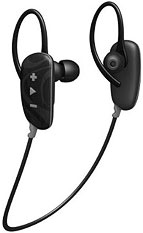 The HMDX Craze are wireless earbuds that fall more in the category here of the Phiaton BT 220, though at the low-end price. So, if you’re looking for something very small, portable and wireless, but don’t want to spend $150, that’s where these fit in.
The HMDX Craze are wireless earbuds that fall more in the category here of the Phiaton BT 220, though at the low-end price. So, if you’re looking for something very small, portable and wireless, but don’t want to spend $150, that’s where these fit in.
These are wireless only, there’s no cord for connecting to your music player. It connected fine to Bluetooth, though took a little longer than some Bluetooth devices. The controls are all in the headset and buttons were fairly large and easy to manipulate. I think I preferred the Phiaton dongle for devices this small, making it particularly easy to manipulate the controls, though if you use earbuds for jogging, having everything in the headset is definitely lighter.
The rechargeable battery takes about three hours to charge – not bad, but that’s a lot when the earbuds are rated for what the website says is six hours of runtime. (And the manual says only four hours of runtime.)
Speaking of the manual, the product didn’t come with one, but you can download it from the website. It also didn’t explain where the speakerphone’s mouthpiece was located. That took a little searching. Know too that this is not a noise-cancelling device, just straight earbuds.
Clearly, the HMDX are a different category than the Phiaton, for all their similarities. They’re for people looking for something basic, Bluetooth wireless and that work well. These do. Not great sound, but solid enough especially for out on the road. And the price at the time of writing is only $25 online, with a retail cost of $40.
- I haven’t tested this product, but have read up about the TurtleCell, which looks interesting. It’s a case for an iPhone 6, but with a clever twist I’ve never seen. It has built-in, retractable earphones, so you never have to carrying around a pair, or deal with them getting twisted. I don’t know the sound quality is, or have convenient it is to switch between your phone’s external speaker and the earphones (since these are, essentially, always connected), but the product is intriguing enough to mention. It should be on the market now, and you can check the website to find out more.
- A couple months ago, I did a column on portable keyboards. Another new model came my way after the fact which I think is worth mentioning. I’ll do a full review later on, but for now I wanted to note it since we’re on the heels of that recent article. It’s the Logitech K380 Multi-Device Bluetooth Keyboard, which you can find here. It has similarities to Logitech’s K480 that I did review, but I much preferred this new device. It has almost as big a keyboard, but the full unit is much smaller and significantly lighter. It too can work with iOS and Android tablets and phones, and Windows tablets all at the same time, just by tapping a button after pairing it. It also costs about $10 less, around $30 online at the time of writing. Only one quibble – there’s no slot or stand for your tablet or phone. You’d have to lay it all on your lap and find something to balance your device against.
To read more from Robert J. Elisberg about other matters from politics, entertainment, technology, humor, sports, and a few things in between, see Elisberg Industries. He can also be followed at a distance on Twitter or Facebook.
Note: The Writers Guild of America West neither implicitly nor explicitly endorses opinions or attitudes expressed in this article.
Copyright 2015, Robert J. Elisberg. All rights reserved.
